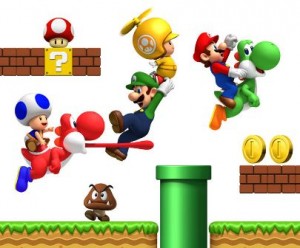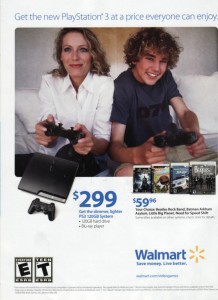New Super Mario Bros. Wii and Video Game Nostalgia
 The Wii is a time machine. Among its features is the Virtual Console, where users download Nintendo classics from earlier generations. Here you can relive the experience of 8-bit Zelda and Mario, or in my case, discover them for the first time. I have been honing my D-pad skills on Super Mario Bros. 3, leaping from platform to platform, collecting coins, jumping on Koopas, advancing level by level. Sometimes while playing on the VC I imagine my teenage self in an alternate history in which I grow up playing Nintendo instead of just hearing about it.
The Wii is a time machine. Among its features is the Virtual Console, where users download Nintendo classics from earlier generations. Here you can relive the experience of 8-bit Zelda and Mario, or in my case, discover them for the first time. I have been honing my D-pad skills on Super Mario Bros. 3, leaping from platform to platform, collecting coins, jumping on Koopas, advancing level by level. Sometimes while playing on the VC I imagine my teenage self in an alternate history in which I grow up playing Nintendo instead of just hearing about it.
The VC is one way the Wii, like much about video game culture, is profoundly nostalgic. New Super Mario Bros. Wii, a current blockbuster, is another. In some ways NSMB Wii is just another in the long line of Mario games stretching back almost thirty years to Donkey Kong. Mario must rescue the princess from evil creatures. While overcoming obstacles and enemies he finds powerups and hidden secrets to help him along. In an era of spectacular computer-generated 3D image-making, NSMB Wii is cheerfully 2D. Compared with the earlier Wii game Super Mario Galaxy, with its clever use of spherical settings, it’s refreshingly, retro flat. But some innovations mark this game off from vintage Super Mario.
One is the “super guide,” which becomes available in single-player mode after a number of failed attempts to finish a level. When activated, the super guide screens a movie of Luigi completing the level in expert style, modeling the right way for struggling novices much as a more experienced and proficient sibling or friend might have done in the old days. This feature allows frustrated noobs like me to figure out a fairly challenging game.
Another new feature is a multi-player mode, where up to four people work together — or at odds with each other — as Mario, Luigi, and Yellow or Blue Toad. You can boost higher jumping off another player’s head, throw each other across chasms, nudge each other off ledges, or hog the powerups that spring from the question-mark blocks. Shigeru Miyamoto, the auteur of the Marioverse, has said he noticed contrasting demeanors in players of the different modes. The player going alone has on the focused game face, evidently absorbed in beating the game. Those playing in a group, by contrast, are social — talking, laughing, encouraging or competing. The way NSMB Wii combines these two modes has positioned the game as a hybrid of so-called casual and hard-core, appealing at once to the Wii bowling party crowds seeking communal diversion and to those for whom play is serious business. It also makes the game a ideal multi-generational experience, with a more proficient parent guiding a child — or vice versa. (Marketing to the whole family is evidently on the agenda of game companies as this ad for Walmart and the PS3 clearly shows.)
But even as the game offers this new format, it exploits the nostalgia factor in the way it lets expert adult gamers relive their years of initiation into gaming by playing with novice kids, in a way that lets the grownups’ skills carry the youngsters along.
Nostalgia is potent because it promises to return to us the lost time we yearn to recapture. For adults who grew up with Nintendo, or even those like me who wish they had, games like NSMB are powerful throwbacks, at once pushing old concepts in new directions and reviving the spirit of past adventures.
***
For more on video games and nostalgia see Zach Whalen and Laurie N. Taylor (eds.), Playing the Past: History and Nostalgia in Video Games (Vanderbilt, 2008).
I have previously written in more personal terms about my own history of playing and not playing video games at my blog zigzigger.




Nice post. I think nostalgia is employed not only because you can make a family appeal, but because such an appeal needs to be made. This recession is partially about job loss, but it will ultimately be about contraction at every level for most Americans. What that means is that if you are going to drop anything above $100 for a luxury item, then it better serve the needs of the entire family. I think the Wii’s push for older, more classic titles is part of this, as is their current embrace of Netflix as well: if you buy a system you absolutely must get more boom for buck. And one of those features is the console as time-machine.
When we were considering getting a Wii an experienced gamer friend of mine said the Wii is the game system for people who don’t like video games. I have to agree–I loved my Nintendo as a kid but the current crop of video games turns me off. Wii definitely taps into those old (happy) feelings.
Nice write up, Mike. I love reading the opinions of new gamers; there’s none of the cynicism and bitterness present in the words of long-term core gamers. Very fresh.
As long as you’re exploring the virtual console, you should check out: Super Metroid, Legend of Zelda: Link to the Past, Kirby’s Adventure, Bubble Bobble, and Contra 3.
I go back to some of the older NES games and I feel like a kid all over again. Nostalgia is great.